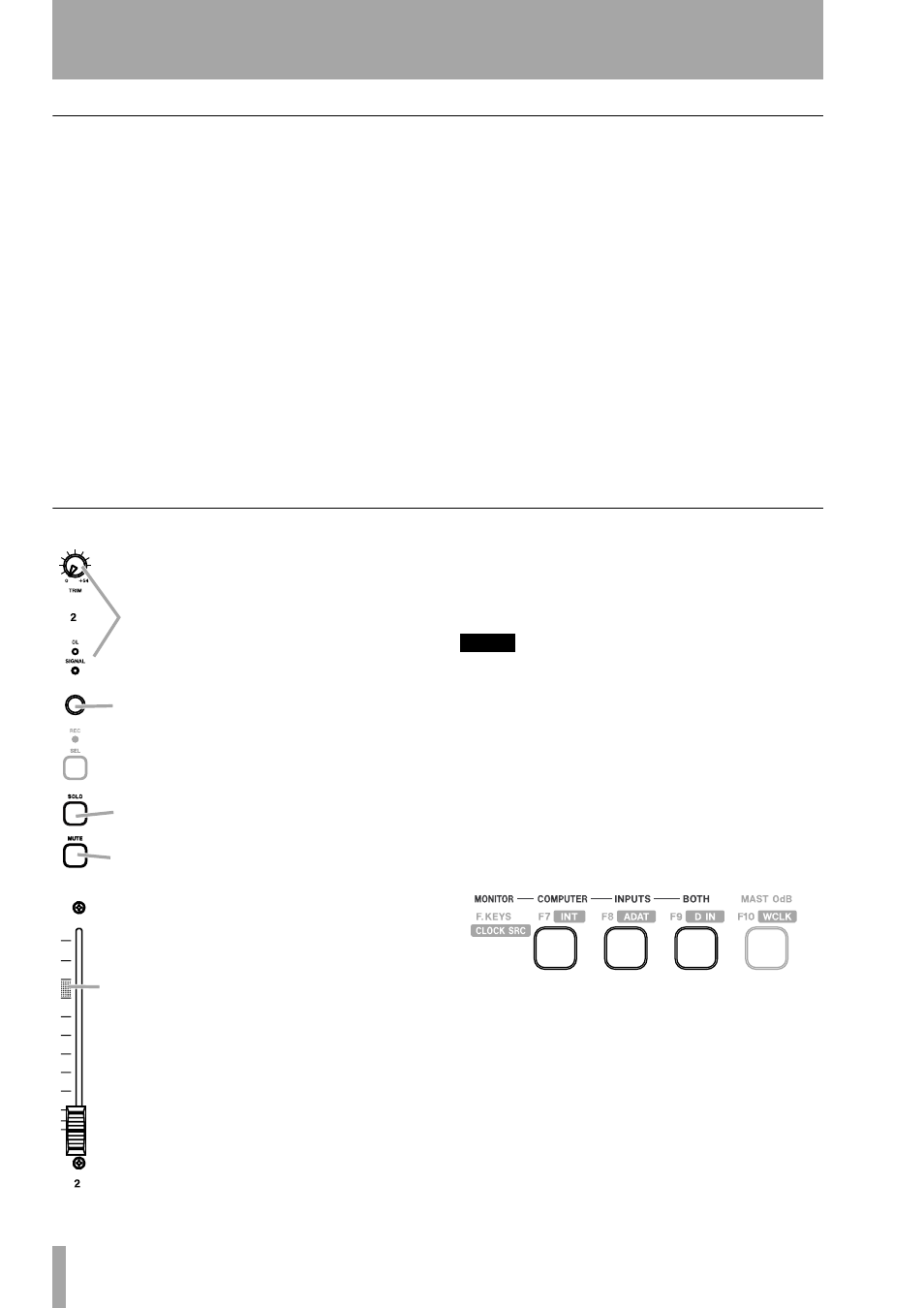1 – introduction – Teac FW-1884 Setup Guide User Manual
Page 4

1 – Introduction
4
TASCAM FW-1884
Setup Guide
MIDI CTRL (control) surface mode
In the MIDI control surface mode, the surface con-
trols are mapped to MIDI control messages. The
BANK
keys and indicators are used to select up to
four banks (that is, 32 modules), and the controls can
be set to transmit a different MIDI message in each
bank.
This mapping of controls to messages is set up in the
FW-1884 Control Panel of the host computer, and the
process is fully described in the main manual. Basi-
cally, you launch the FW-1884 Control Panel on the
host computer, then press and hold the FW-1884’s
SHIFT
key (bottom left of the FW-1884 control sur-
face) and press the
MIDI CTRL
key to enter the pro-
gramming mode.
You may then follow the on-screen instructions to
continue with the programming.
When a control is mapped to a particular MIDI out-
put port in this mode, when the control is operated,
the appropriate
OUT
indicator (green) lights up as the
MIDI data is transmitted from the FW-1884.
Note that you do not need to connect the FW-1884 to
a host computer to operate the unit in this mode—
you only need to connect a computer when you set
up and map the MIDI messages.
MIDI THRU routing capability is also available in
standalone mode. See the section on MIDI connec-
tions "MIDI Routing" on page 11 for details. In this
MIDI control mode, if a computer is connected, the
surface controls may also be used to generate MIDI
messages passed through the MIDI control port.
MON MIX (monitor mix) surface mode
In this surface mode, the FW-
1884 acts as a stand-alone
mixer, mixing up to eight ana-
log signals together with eight
ADAT “lightpipe” signals and
two digital signals received at
the coaxial digital input.
The FW-1884 provides level,
pan, mute and solo capabili-
ties for these eighteen input
channels, mixing them into
two outputs (
SURROUND
MONITOR (BAL) 1/L
and
2/
R
). Surround mixing is not
possible in this mode.
It is also possible to monitor
the signals output from the
computer DAW software,
either independently, or
together with, the input sig-
nals.
Three banks are available
using the
BANK
keys: the ana-
log (
ANLG
), ADAT and the
stereo digital input (
D IN
)
banks. In the last of these,
only the first two modules are
active, corresponding to the
stereo S/PDIF or AES/EBU
inputs.
When mixing analog signals, the
TRIM
controls can
be used to adjust the signal input levels, which can be
monitored with the overload (
OL
) and signal detec-
tion (
SIGNAL
) indicators on each module.
NOTE
When mixing digital audio, there should be one, and
only one word clock in the system. Follow the instruc-
tions in "Word sync setting" on page 14 to set the word
clock for the system.
Use the master fader to control the master stereo
level, and the
MONITOR
control to adjust the level of
the signal sent to the control room monitoring system
(
1/L
and
2/R
) or outputs
1
—
8
((DAW signals only.
When the FW-1884 is in the monitor mix mode, the
first three function keys of the top row are used for
selecting the signals to be monitored:
•
COMPUTER
selects the signals from the DAW
passed through the FireWire connection. The level
of the signals from the computer is set using the
master output control of the DAW software and the
8 analog outputs may be selected (using the soft-
ware Control Panel) for output of these signals.
•
INPUTS
selects the analog, optical and coaxial sig-
nals for monitoring.
•
BOTH
allows the computer signals to be monitored
alongside the input signals
Pan control
Solo control
Mute control
Signal level
fader (and
nominal
position)
TRIM control
and
overload &
signal
indicators
(used on
analog
inputs only)
